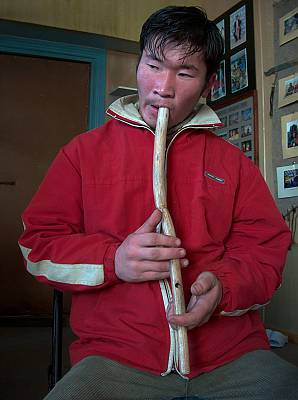Traditional music of the Tsuur
Inscribed in 2009 (4.COM) on the List of Intangible Cultural Heritage in Need of Urgent Safeguarding
Country(ies): Mongolia
Identification
Description

- Traditional music of the Tsuur
- © 2006 by S. Yundenbat
Tsuur music is based on a combination of instrumental and vocal performance – a blending of sounds created simultaneously by both the musical instrument and the human throat. Tsuur music has an inseparable connection to the Uriankhai Mongolians of the Altai Region, and remains an integral part of their daily life. Its origins lie in an ancient practice of worshipping nature and its guardian spirits by emulating natural sounds. The Tsuur is a vertical pipe-shaped wooden wind instrument with three fingerholes. Simultaneously touching the mouthpiece of the pipe with one’s front teeth and applying one’s throat produces a unique timbre comprising a clear and gentle whistling sound and a drone. The Tsuur is traditionally played to ensure success for hunts, for benign weather, as a benediction for safe journeys or for weddings and other festivities. The music reflects one’s inner feelings when travelling alone, connects a human to nature, and serves as a performing art. The Tsuur tradition has faded over recent decades as a consequence of negligence and animosity toward folk customs and religious faith, leaving many locales with no Tsuur performer and no families possessing a Tsuur. The forty known pieces preserved among the Uriankhai Mongolians are transmitted exclusively through the memory of successive generations – a feature making this art highly vulnerable to the risk of disappearing.
Documents
- Nomination form: English|French
- Consent of communities: Mongolian/English
Decision 4.COM 14.11
The Committee (…) decides that [this element] satisfies the criteria for inscription on the List of Intangible Cultural Heritage in Need of Urgent Safeguarding, as follows:
- U1: Deeply rooted in the nomadic ways of life of the Uriankhai ethnic group of the Altai Mountains in north-western Mongolia, the traditional music of the Tsuur is an important part of the people’s relationship with their natural environment and a critical element in assuring their survival within it, as it accompanies daily activities and animal herding as well as religious ceremonies and rituals;
- U2: Despite a growing awareness and concern about local and regional traditional cultural forms, and the willingness and active commitment of apprentices to preserving the element, the tradition of the Tsuur is threatened by developments such as an ever-growing appeal of cosmopolitan lifestyles, migration to urban areas, processes of urbanization and industrialization, the loss of the cultural contexts for its practice and the passing of Tsuur performers;
- U3: An ambitious set of safeguarding measures, including the support of performers and teachers, the identification of aspiring players, or the preparation of audio-visual training materials, while raising the legal status of the Tsuur, addresses essential needs and can be expected to have a lasting impact on the element’s viability;
- U4: The nomination has been elaborated with the active involvement of the Tsuur-playing community, in particular the Hunnic Tsuur Performers’ Association, key Tsuur performers, and communities in several counties that have shown their willingness to safeguard Tsuur playing and have given their free, prior and informed consent to its nomination;
- U5: The Uriankhai Mongolian Tsuur is inscribed on the National Urgent Safeguarding List of Elements of Intangible Cultural Heritage and the National Registrar of the Elements of Intangible Cultural Heritage kept by the Cultural Heritage Center under the Ministry of Education, Culture and Science of Mongolia.
Slideshow
Video
© 2009 by National Centre for the Intangible Cultural Heritage
These videos (and many more) can also be consulted through the UNESCO Archives Multimedia website











